Advanced Telescope Supplies
Australia's Premier CCD and Astro-Imaging Experts
CCD Imaging.
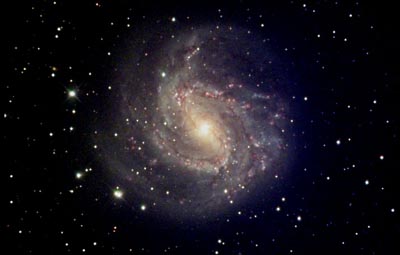 Charge
Coupled Devices or CCD's are now the tool of choice for most professional
observatories and an ever increasing number of amateur astronomers.
Charge
Coupled Devices or CCD's are now the tool of choice for most professional
observatories and an ever increasing number of amateur astronomers.
A CCD equipped 130mm aperture telescope is literally more sensitive than a 1 metre class telescope equipped with a standard photographic camera.
Advanced Telescope Supplies are Australia's most experienced dealers for SBIG CCD cameras. Take a moment to look at our latest CCD Image Gallery. Then do a search of the web for CCD images taken using cameras other than SBIG. Ask some critical questions. Are the images noisy? how well guided are they? how deep do they go? Was a massive telescope used to take the image?
SBIG offer a comprehensive range of cameras that allow you to capture images using very modest equipment that will rival or better those taken by professional observatories just a decade ago using film. A skilled amateur equipped with a CCD camera can also perform accurate astrometric and photometric studies, spectroscopy and do real science with their camera.
Before you attempt any CCD imaging you will however need the following:
- An equatorially mounted telescope (i.e Alt Azimuth mounted computerized telescopes are NOT suitable)
- Dual axis telescope drive and corrector/hand paddle
- Personal computer (note: Macintosh support is limited with many manufacturers)
You DO NOT need
- A large telescope (4-6" aperture telescopes can deliver superb images)
- A dark sky (CCD imaging can be done from bright city skies)
- A governmental budget (Around $A3000, i.e. the price of a high quality photographic camera, will buy an excellent CCD)
Be wary of
- Fork mounted telescopes. The are often mechanically unstable. Larger CCD cameras will not clear the base of the fork arms when the telescope is pointed near the pole.
- Cheap one shot colour cameras for Deep Sky imaging. Images are lower in quality due to the miniscule CCD size.
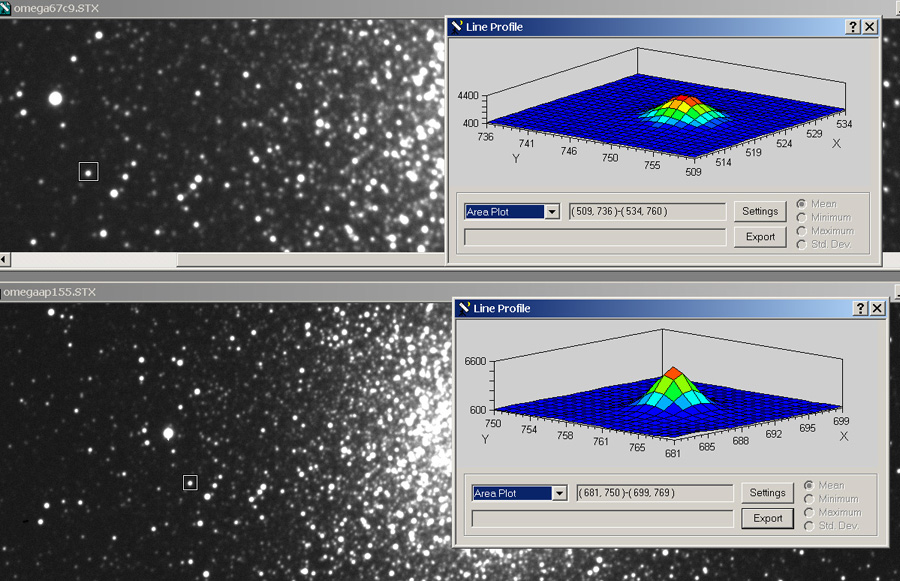
Note the intensity plot above. It compares an intensity plot of the same star in a pair of images of the same object taken within a few minutes of each other, first through a 9.25' SCT then through a premium 6" APO refractor. The smaller instrument shows a higher and sharper peak! While mass produced telescopes may be good value for money, the performance of a superb yet smaller instrument allows users to detect fainter stars with shorter exposures!
What can cause problems
- Less expensive refracting telescopes often have poor infra-red correction, which will blur CCD images
- Fork mounted telescopes have limited room between the back of the telescope and the drive base, which may interfere with larger CCD cameras and accessories.
Additionally CCD images can be greatly enhanced by the use of
Which brand of CCD should I choose?
The latest developments in the use of microlens technology has vastly improved the performance of the latest black and white interline and full frame CCD's. When used with interline CCD's their performance can rival that of conventional full frame CCD's. When coupled with full frame CCD's microlensed CCD's such as the Kodak ME series, the Quantum Efficiency, being the ratio of detected photons compared to the total number falling on the detector, peaks at around 85%. Due their structure The best interline devices can achieve is around 20% down from that figure.
A novel method of guiding with an interline device is to use each alternate row of sensors for readout and guiding during imaging, but this effectively reduces the sensors efficiency by 50% and introduces a significant amplifier readout glow in the corner of the image frame, further reducing the Signal to Noise ratio of the sensor. But, why would you want to choose a detector that is virtually blind to nearly half of the the starlight you are trying to capture? Self guiding technology patented by SBIG places no such restrictions on camera performance. But using two ( an optional external remote guide head makes this total of three) independent sensors SBIG cameras can guide using the telescopes main optics ( or in the case of the remote guide head, a separate guidescope. e-finder or off-axis guider) to seamessly guide the telescope will no loss of information going to the main imaging sensor.
A little more about CCD's......
| Dark current |
|
| Linearity |
|
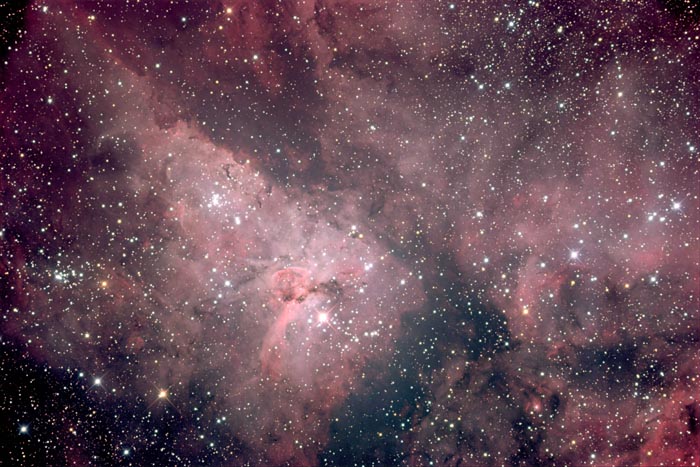
Pictured Left, SBIG CCD image of Eta Carina
CCD's have some rather nice properties for Astroimaging. They have excellent quantum efficiency, linear sensitivity, high signal noise ratios and digital output. In short, image data can be efficiently collected processed and displayed in a number of ways. Despite the high initial cost of ownership (though, prices are still falling) CCD's are very cheap to run, certainly much less expensive than film. CCD's themselves come in various forms such as interline transfer CCD's, linear CCD's and frame transfer CCD's. A standard black and white front illuminated array CCD is seen by many as the best choice for amateur Astronomical applications, as they are easy to produce hence are affordable and have high resolution. For photometric work chips should not be fitted with an anti-blooming gate (ABG). These cause a loss of linearity of the detector beyond approximately 50% full well capacity. ABG's do however give massive overexposure protection and are an excellent choice if astro-imaging or astrometry is the primary application. Back illuminated CCD's perform well toward the blue end of the spectrum, and should be considered for UV and tri-colour work.
When purchasing a CCD camera things to consider are: detector size, D/A resolution, signal to noise ratios, quantum efficiency, pixel size and cooling of the detector.
To effectively employ a CCD detector to take astronomical images that aesthetically rival (or exceed) the quality film one needs to adopt a fairly terse regime of techniques and equipment. Telescope mountings need to be rigid and exceptionally smooth in their tracking abilities. Telescope optics need not be overly wonderful, though fast F-ratios do help. An often overlooked fact is that the physical size of the airy disc in any optical system is purely due to the F-ratio of that system. It is independent of aperture! The downside of this equation is, to obtain any sort of image scale, long focal lengths are required. A standard Celestron 14 has a focal length of around 4 metres at its prime focus of F11. That is an airy disc that is 10 times larger that that delivered by the F1.1 focal ratio of the 4 metre aperture Anglo Australian Telescope.
It is true however, to say a Celestron 11 at F6.3 still may still deliver star images that are larger than say a short focus 4 inch F7 refractor.
Image scale is the key, as our C-11 is looking at a
much smaller angular patch of sky, where atmospheric turbulence, drive
tracking errors, wind buffeting and a host of other factors conspire to
smear incoming starlight over a much greater area on the CCD detector,
despite the physically smaller airy disc in the F6.3 instrument. Scattering
of light over the detector is also more pronounced as aperture increases.
What was a tiny pinprick of light in a small aperture, is often revealed as
a blazing sun in an instrument of significant aperture....hence the bad run
that images from commercial SCT's often (unfairly) receive, as they are
often being compared to images of vastly different scales, F-ratios and
intensity levels.
If there is a single rule of CCD imaging it probably would be: Focus Accurately.
Many CCD images show poor attention to focus. Use a Hartmann mask or Diffraction Focuser if you are unsure. Linked with focus is tracking and seeing which also smear light over area rather than a point. Short of launching our telescope into orbit, we can not do much about the seeing, also there is little worth in attempting a high resolution (read: long focal length) image when the seeing is bad. Use a shorter focal length or wait for a better night.
Good tracking is intrinsic in the qualtiy and
design of a telescope mount. Things to look for are: large gears, large
thrust surfaces and ground worms and large numbers of worm wheel teeth. Worm
gears should be bearing ( not spring) mounted. Declination tangent drives
give more immediate and desirable drive reversal than a worm and wheel.
Machined components are usually more rigid than cast components. Spur
gears often have large instantaneous tracking errors and should be avoided.
Three manufacturers spring to mind. Losmandy, Astro-Physics and Byers. The
heavier Takahashi mounts are also very good, but very expensive for their
payload ratings. Commercial fork mounts are generally not as rigid as the
former, they also do not allow bulky equipment (ie CCD's) to swing between
the fork arms when used at high declinations hence should be avoided.
Glossary of CCD Imaging Terms.
Anti-blooming.
 Should
a pixel of a CCD saturate with too much light, its charge well will overflow
into the adjacent pixel, which may also overflow etc. This gives a streak in
the image (pictured at left). This effect may be reduced by the addition of
a "anti-blooming gate" or ABG to the surface of the CCD (the gate
is a thin metal film, which effectively bleeds off any excess charge). ABG's
can give over 100x overexposure protection, however they typically reduce
the sensitivity of the CCD by around 20-30%, cause a reduction in full
well capacity and slight reduction in resolution of the array.. With
applications such as photometry, non-ABG is the CCD detector of choice, as
ABG chips also lose linearity as they start to exceed 50% full well
capacity. For Astrometry and imaging ABG chips work well.
Should
a pixel of a CCD saturate with too much light, its charge well will overflow
into the adjacent pixel, which may also overflow etc. This gives a streak in
the image (pictured at left). This effect may be reduced by the addition of
a "anti-blooming gate" or ABG to the surface of the CCD (the gate
is a thin metal film, which effectively bleeds off any excess charge). ABG's
can give over 100x overexposure protection, however they typically reduce
the sensitivity of the CCD by around 20-30%, cause a reduction in full
well capacity and slight reduction in resolution of the array.. With
applications such as photometry, non-ABG is the CCD detector of choice, as
ABG chips also lose linearity as they start to exceed 50% full well
capacity. For Astrometry and imaging ABG chips work well.
Astroimaging
Astrophotography by another name, with the subtle difference being the type of detector used to take a picture of the heavens, in this case a CCD.
Back Illuminated CCD's
Some CCD's are designed to be illuminated through their substrate layers. The substrate needs to be "thinned" which is a major cause for chip failure during manufacture, hence they are costly. Such "back illuminated" CCD's however have excellent quantum efficiencies, in the order of 90-97%%. and perform extremely well at the blue end of the spectrum.
CCD
Charge coupled device. A an electronic light detector which uses the photo-electric effect (vis: light from a photon causing a an electron to be emitted from a metal substrate) to detect incoming packet or quanta of light.
D/A resolution
The Digital to Analogue resolution is a measure of how discreetly a signal can be measured. Most systems are 16 bit
that is 2 to the power 16 or approximately 65,000 discreet brightness levels can be recorded.
Diffraction Focuser
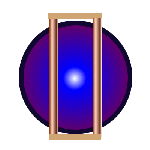 A
Diffraction Focuser may be simply constructed from two pieces of timber or
dowel which are placed in parallel over the aperture end of a telescope. Out
of focus stellar images will reveal a pair of diffraction spikes, which will
merge into a single spike when best focus is achieved.
A
Diffraction Focuser may be simply constructed from two pieces of timber or
dowel which are placed in parallel over the aperture end of a telescope. Out
of focus stellar images will reveal a pair of diffraction spikes, which will
merge into a single spike when best focus is achieved.
Fast Guiding
A tip-tilt optical system which can be used to rapidly correct the position of a star, which may be in error due to atmospheric scintilation or telescope drive errors.
The fractional area of a pixel that is sensitive to light.
Frame transfer CCD's
A frame transfer CCD consists of two arrays, one of which is masked. Output from the unmasked array can be transfered rapidly to the masked area, which is then read at a slower rate. The ability to rapidly transfer data from the unmasked array allows for very short exposure times, which are ideal for planetary imaging.
Front Illuminated CCD
Most CCD's detect light through their top surface, where their anti-blooming gates and charge transfer surfaces are also located. Incoming photons are absorbed by these surfaces, which in turn do not generate a charge, hence there is a loss in the efficiency of the detector, particularly at the blue end of the spectrum. Many manufacturers now use transparent gate structures that significantly improve the QE of CCD's.
Full Well Capacity
The total number of electrons that can be stored in a pixel of a CCD
before it becomes saturated. Chips such as the Kodak KAF series with 9
micron pixels can store approximately 85,000 electrons before becoming
saturated or "full". Chips such as the SITe 512x 512 back
illuminated series have larger 24 micron pixels and can absorb 350,000
electrons before saturating.
FWHM.
Short for Full Width Half Maximum. Plotting
the intensity curve of a star, then measuring radius (n pixels) from the
centre to where the intensity value that half that of the peak gives the
FWHM value. This value is useful for determining the point spread radius
star. This radius can be affected by a number of factors, but most commonly
telescope focus and atmospheric turbulence.
F-Ratio
The focal length of an optical system, divided by its aperture. Hence a telescope of 200mm aperture with a 2000mm focal length with have a F10 focal ratio. "Fast" telescopes are around F4.5 or lower.
Hartmann mask
 A
device which may be used to accurately test the focus a telescope. In its
simplest form it could be described as a lens cap with two symmetrical holes
cut through it. The mask is placed over the aperture end of the
telescope prior to focusing. If the telescope is not at best focus the airy
disk of a star is broken into two components, which merge as best focus is
achieved. Unfortunately, atmospheric turbulence can make this point of best
focus shift around so it is best to assess the focus over a range of
positions before committing to a deep CCD exposure (with the mask removed! )
A
device which may be used to accurately test the focus a telescope. In its
simplest form it could be described as a lens cap with two symmetrical holes
cut through it. The mask is placed over the aperture end of the
telescope prior to focusing. If the telescope is not at best focus the airy
disk of a star is broken into two components, which merge as best focus is
achieved. Unfortunately, atmospheric turbulence can make this point of best
focus shift around so it is best to assess the focus over a range of
positions before committing to a deep CCD exposure (with the mask removed! )
Interline transfer chips (CCD's)
CCD chip manufacturers also make CCD's specialized for television
applications. Standard NTSC or PAL video images are built up by displaying
alternate field lines of an image in quick succession. Unfortunately such
devices lack the resolution of an array CCD.
Linear CCD's
The pixels of a linear CCD are arranged in a single line, and are used in as fax machines, scanners and applications such as spectroscopy
Pixel
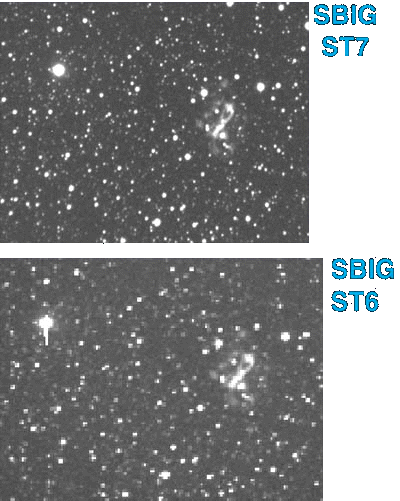 A
picture element or pixel is the smallest part of a digital
image or a single light detecting element of a CCD detector.
A
picture element or pixel is the smallest part of a digital
image or a single light detecting element of a CCD detector.
Detectors such as the Kodak KAF 0400 consist of an array of 765 by 512 pixels, each being 9 microns square. Detectors such as the Texas Instruments 245 chip have 23 x 27 micron pixels.
By virtue of their large collecting area, larger pixels have higher sensitivities and full well capacities. Despite the improved sensitivity of large individual pixels their sampling, hence detecting ability for point sources at a given focal length is not as good as smaller pixel arrays.
The images at left were taken with identical optical systems (C-11 at F6.3) and clearly show the superiority of small pixels when matched to this focal length in detecting faint stars. Extended sources of light such as nebulosity are more clearly revealed with the large pixel ST6 chip.
Current wisdom states that optical systems should be matched to give approimately 2 arc seconds per pixel.
The formula s= (205 x pixel width)/focal length (mm) will give the
sky coverage of each pixel for a given focal length.
Quantum Efficiency
The quantum efficiency of a CCD detector (or QE) is a measure of how well it converts incoming light into a detectable signal. A QE of 100% means that all every single photon of light coming from an object is converted into a detectable charge.
Back illuminated detectors have the best QE to date with efficiencies close to 98%.
Detectors
such as the Kodak KAF "e" series have peak efficiencies around
65%, dropping to 20% at the blue end of the spectrum. Most manufacturers now
employ micro-lenses over each pixel to further increase the sensitivity of
their CCD's. The Kodak KAF3200 series boasts peak QE's of around 87%
Seeing
Seeing is way of describing the amount of turbulence or distortion the
earths atmosphere imparts to the image seen through a telescope. Good seeing
usually allows a star's diffraction pattern to be clearly seen, whereas
really bad seeing makes it almost impossible to focus the telescope.
Signal to noise ratio
A measure of the detection limit of a CCD system is how well it can separate starlight (signal) from skyglow, thermal electrons and other forms of noise. The S/N ratio can improved by cooling the CCD detector to remove thermal sources of noise. Most manufacturers use thermo-electric pieltier elements and or cooling fans to cool the CCD from 30 to 50 degrees Celsius below ambient.
Tracking
Tri-Colour Process.
By taking filtered red, green and blue exposures, and them combining them, one can create a full colour image of an object. Helmholtz is best known for first describing this "additive" colour process. For example, say we have a blue object. When viewed through red or green filters it will appear dark. A blue filter will however transmit most of the object's light through to the detector. Combining our exposures our object has, no red, no green, yet strong blue intensity or brightness levels. Hence our combined image of the object appears blue.
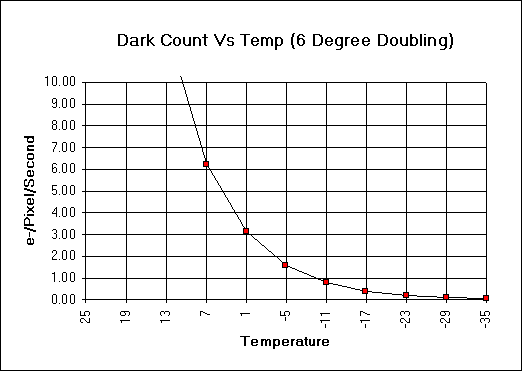 Thermal
noise can be reduced by a factor of 2x for each 6
degrees of cooling applied.
Thermal
noise can be reduced by a factor of 2x for each 6
degrees of cooling applied.